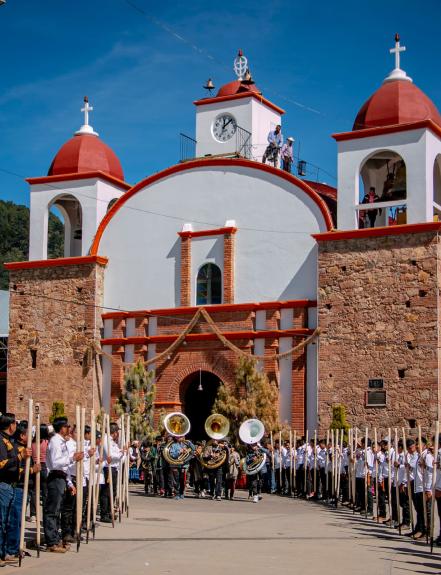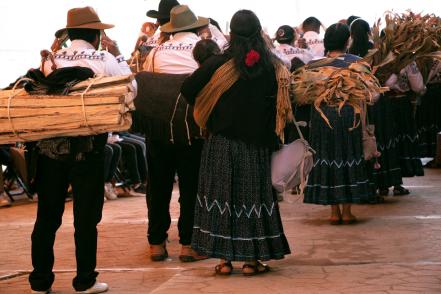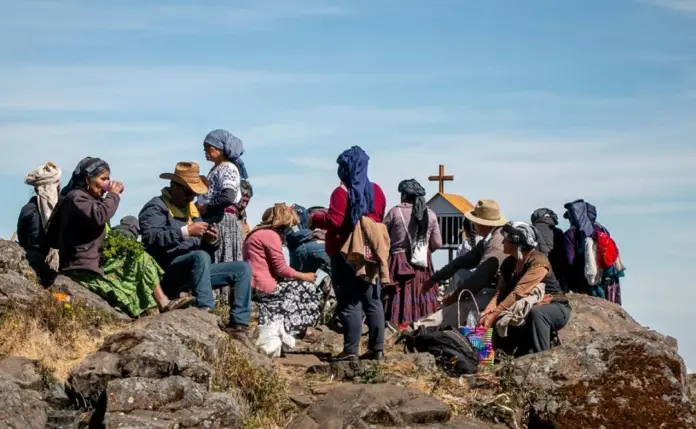“Since we are born, we already know why we come, to serve the people, so we do it with great pleasure. People may think it is a lot of partying, but it is part of what we experience every year,” says one of the young people who was appointed as a member of the Health Council for 2025. Along with him, 111 other people will offer their community service in Santa María Tlahuitoltepec, a town of the Ayuujk nation located in the Sierra Norte region of Oaxaca.
In a solemn ceremony, the new authorities, women and men dressed in their traditional clothing of this community famous among the Mixe people (as they are also called) for being the birthplace of musicians, enter in rows on the municipal court. They line up on the edge of the court, while the rest of the population watches and accompanies them from the stands. Each of the words of the act is Ayuujk, since almost 95% of the population here are speakers of this language, according to official data.
The outgoing authorities wave the flag of their nation and of the Communal Property, and then hand them over to the new servants. All those present cross their arms in greeting to their flag. Then, they sing their anthem, with their right hand raised, while the municipal philharmonic band plays.
The Ayuujk (Mixe) flag, with its colors: green, maroon and yellow, represents the three regions into which the Sierra Mixe is divided, a microregion or district of the Sierra Norte where 19 towns or municipalities inhabited by this indigenous nation are located, one of the 16 officially recognized as settled in the territory of Oaxaca.
In the center is Mother Earth represented with an oval with the image of Konk Ëy and her sister, the snake, ancestral Ayuujk deities who are worshipped. In addition, the Cempoaltépetl hill appears and the Kamapytï inscription, a bow and five arrows representing the 500 years of resistance since the arrival of the Spanish.
Minutes later, according to their community protocol, the outgoing authorities also hand over the national flag of Mexico to the new ones, and then sing the Mexican national anthem in Spanish, accompanied by the philharmonic band.
At the end of the civic act, in a gesture of harmony, respect and cordiality, each of the outgoing authority members hands over the baton of command, the seal that makes their acts and decisions official, the keys to their offices and mezcal to their colleagues who are replacing them for the 2025 administration.
During the act, each of the people are introduced with their colleagues with whom they will share the position, in addition to those who will be in charge of each Secretariat, as well as the members of the councils.
Before the civic act, fireworks are set off, while the municipal philharmonic band of Tlahuitoltepec plays outside the church, after the midday mass, in which the town priest offers a mass for the new authorities.

Hundreds of authorities
In Santa María Tlahuitoltepec, located 117 kilometers from the city of Oaxaca and with a population of almost 10 thousand people, according to the Population Census of the National Institute of Statistics and Geography (Inegi), the municipal council is made up of the mayor, a traditional position, and even the last member of all the councils, so in total they add up to around 112 people.
Added to them are the agrarian authorities, another 48 members, the community security body made up of about 70 topiles and senior officers. In total, with other positions and auxiliary authorities, only in Tlahuitoltepec, about 700 people take a community position each year for 365 days.
For this 2025, the incoming authorities were appointed at the end of last July, and at the beginning of August, by show of hands, at the community assembly. A week after the election, the members assume their responsibilities and begin planning to take power on January 1st, after noon.
They celebrate with food for the people
It is January 1st. After the transition ceremony, the incoming authorities offer lunch and dinner in the community kitchen. The day is about to end. To close the ceremony of the transition of power of the Ayuujk people, a ritual dance is performed in a circle, a dance to which everyone is invited.
“You invite your people to the ritual dance, as part of a commitment to joy. It is this part of integration, in the middle the leaders dance. And around them are also in a circle, the security like the topiles and the elders in command,” explains Rubén Hernández, a community member and one of the coordinators of the community radio of Tlahuiltoltepec, who has assumed various community services.
Community ritual
Before taking office, in Tlahuitoltepec the authorities perform a series of rituals to pray for the people, also requesting the wisdom to lead each position during the year.
Among the most important rituals is the request and the offering to the Cempoaltépetl hill, a sacred place for the Ayuujk people.
“We, as inhabitants of this municipality, have a lot of connection with the cosmos, that is, there is a very strong cosmogony regarding assuming a position, because it is a great responsibility. We offer so that things go well for us during the course of the year, there is also an issue of syncretism, in the Catholic aspect and well, then this whole communion is done to pray for the community, for our members who make up the Council,” explains Rubén, who has served as topil and councilor, among other positions.
In the offering to Cempoaltépetl, food such as tepache, mezcal, tortillas enchiladas with eggs, flowers, candles, votive candles, copal and birds are shared.
Community government system, part of autonomy
Unlike the Mexican State government system, for the Ayuujk people, as well as the other 16 indigenous peoples of Oaxaca, those who acquire a community service are not paid.
“When we are born, when a human being comes, a Mixe, both male and female, there is a speech that is given first. That they have well-being and good development in the physical and mental aspect, but this new being is also given a slogan to serve their community,” says the coordinator of the community radio.
In Tlahuitoltepec, a person begins their community service from the age of 15 or 16: “If one is finishing secondary school or high school and is no longer studying, then they can already be appointed.”
In this community, as in the rest of the Mixe region, positions are tiered. To occupy the position of municipal president, mayor, trustee or commissioner of communal property, at least 13 community positions or services must be held.

Regarding this system of government, the municipal mayor, Erasmo Hernández González, indicates that with it “human relations, communication, coexistence and brotherhood are fostered. When the community appoints you, it is because there is trust and one must identify with the people, living with them, and this is part of a resistance.”
He also reminds young people that they must assume their responsibilities with the community in order to learn, “sometimes, they generate writings that add sauce, but they have not tried what the sleepless days of work are like, so that they can promote this daily life.”
Source: oaxaca.eluniversal




